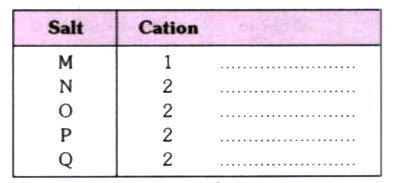A student added excess of sodium hydroxide solution to each of the salt solution . An insoluble precipitate formed was observed in :
Calcium nitrate
Zinc nitrate
Lead nitrate
Sodium nitrate
To solve the question, we need to determine which salt solution forms an insoluble precipitate when excess sodium hydroxide (NaOH) is added. We will analyze each of the given salt solutions: calcium nitrate, zinc nitrate, lead nitrate, and sodium nitrate.
1. Identify the salts and their reactions with NaOH:
- Calcium Nitrate (Ca(NO3)2):
- Reaction:
Ca(NO3)2+2NaOH→Ca(OH)2↓+2NaNO3
- Calcium hydroxide (Ca(OH)2) is formed, which is an insoluble precipitate.
2. Check for Zinc Nitrate (Zn(NO3)2):
- Reaction:
Zn(NO3)2+2NaOH→Zn(OH)2↓+2NaNO3
- Zinc hydroxide (Zn(OH)2) is formed, which is a white precipitate but is soluble in excess NaOH.
3. Check for Lead Nitrate (Pb(NO3)2):
- Reaction:
Pb(NO3)2+2NaOH→Pb(OH)2↓+2NaNO3
- Lead hydroxide (Pb(OH)2) is formed, which is also a white precipitate but is soluble in excess NaOH.
4. Check for Sodium Nitrate (NaNO3):
- Sodium nitrate does not react with NaOH as it is already a sodium salt. Therefore, no precipitate is formed.
5. Conclusion:
- The only salt that forms an insoluble precipitate when excess NaOH is added is Calcium Nitrate (Ca(NO3)2), which forms calcium hydroxide (Ca(OH)2) that is insoluble in excess NaOH.
Final Answer:
The insoluble precipitate formed when excess sodium hydroxide is added is from Calcium Nitrate (Ca(NO3)2).
---
- Calcium Nitrate (Ca(NO3)2):
- Reaction:
Ca(NO3)2+2NaOH→Ca(OH)2↓+2NaNO3
- Calcium hydroxide (Ca(OH)2) is formed, which is an insoluble precipitate.
- Reaction:
Zn(NO3)2+2NaOH→Zn(OH)2↓+2NaNO3
- Zinc hydroxide (Zn(OH)2) is formed, which is a white precipitate but is soluble in excess NaOH.
- Reaction:
Pb(NO3)2+2NaOH→Pb(OH)2↓+2NaNO3
- Lead hydroxide (Pb(OH)2) is formed, which is also a white precipitate but is soluble in excess NaOH.
- Sodium nitrate does not react with NaOH as it is already a sodium salt. Therefore, no precipitate is formed.
- The only salt that forms an insoluble precipitate when excess NaOH is added is Calcium Nitrate (Ca(NO3)2), which forms calcium hydroxide (Ca(OH)2) that is insoluble in excess NaOH.
The insoluble precipitate formed when excess sodium hydroxide is added is from Calcium Nitrate (Ca(NO3)2).
Topper's Solved these Questions
Similar Questions
When Al is added to sodium hydroxide solution:
View SolutionExcess of sodium hydroxide is added to zinc hydroxide.
View SolutionTin dissolves in excess of sodium hydroxide solution to form _____________ .
View SolutionExplain the following:
(i). Copper hydroxide is soluble in ammonium hydroxide but not in sodium hydroxide.
(ii). A dark blue precipitate is formed when sodium hydroxide solution is added to copper sulphate solution. The precipitate darkens on heating.
View SolutionA white solid P, on strong heating, decomposes to give reddish brown gas R and a residue Q. The residue R is yellow when hot and white when cold. The solution of white solid P in water gives white precipitate S, with concentrated sodium hydroxide. The white precipitate S dissolves in excess of sodium hydroxide solution to form colourless solution.
Another sample of the solid P in water is mixed with ferrous sulphate solution and then to this solution are added a few drops of conc. sulphuric acid. A brown ring is formed at the junction of liquids. Answer the following questions:
Name the salt formed when S dissolves in excess of sodium hydroxide.
View SolutionA white solid P, on strong heating, decomposes to give reddish brown gas R and a residue Q. The residue Q is yellow when hot and white when cold. The solution of white solid P in water gives white precipitate S, with concentrated sodium hydroxide. The white precipitate S dissolves in excess of sodium hydroxide solution to form colourless solution.
Another sample of the solid P in water is mixed with ferrous sulphate solution and then to this solution are added a few drops of conc. sulphuric acid. A brown ring is formed at the junction of liquids. Answer the following questions:
Name the white precipitate S.
View SolutionA black solid P dissolves in warm and dilute HCI to form greenish yellow solution Q, but does not give off any gas. The solution Q on treating with ammonium hydroxide forms bluish white precipitates of R. The precipitates of R dissolve in excess of ammonium hydroxide. solution to form deep-blue colouration. Identify solid P and bluish white precipitates of R.
Write equations for action of excess of ammonium hydroxide on R.
View SolutionSalts M, N, O, P and Q undergo reactiom (i) to (v) respectively.
Identify the cation present in these salts on the basis of these reaction. Tabulate your answer in the format given below.
1. When sodium hydroxide solution is added to the salt M, and heated strongly a colourless gas with a pungent smell is evolved which turm red litmus paper blue and gives dense white fumes with a moist glass rod with hydrochloric acid.
2. Addition of dilute hydrochloric acid to a solution of N gives a thick white precipitate which is soluble in hot water.
3. When ammonium hydroxide solution is added to the solution of 0 a light blue precipitate is obtained which is soluble in excess of ammonium hydroxide to form an inteme deep blue solution.
4. When ammonium hydroxide solution is added to the solution of P reddish brown (mustard colour) precipitate is obtained which ,is insoluble even in the excess of ammonium hydroxide solution.
5. When sodium hydroxide solution is added to the solution of Q a which coloured gelatinous precipitate is obtained which is soluble in excess of sodium hydroxide to form a clear solution

View SolutionIdentify the cation in each of the following case
Sodium hydroxide solution when added to solution C gives bluish white precipitate which is insoluble in excess.
View SolutionIdentify the cation in each of the following case
Ammonium hydroxide solution when added to the solution B gives white precipitate which dissolves in excess
View Solution
